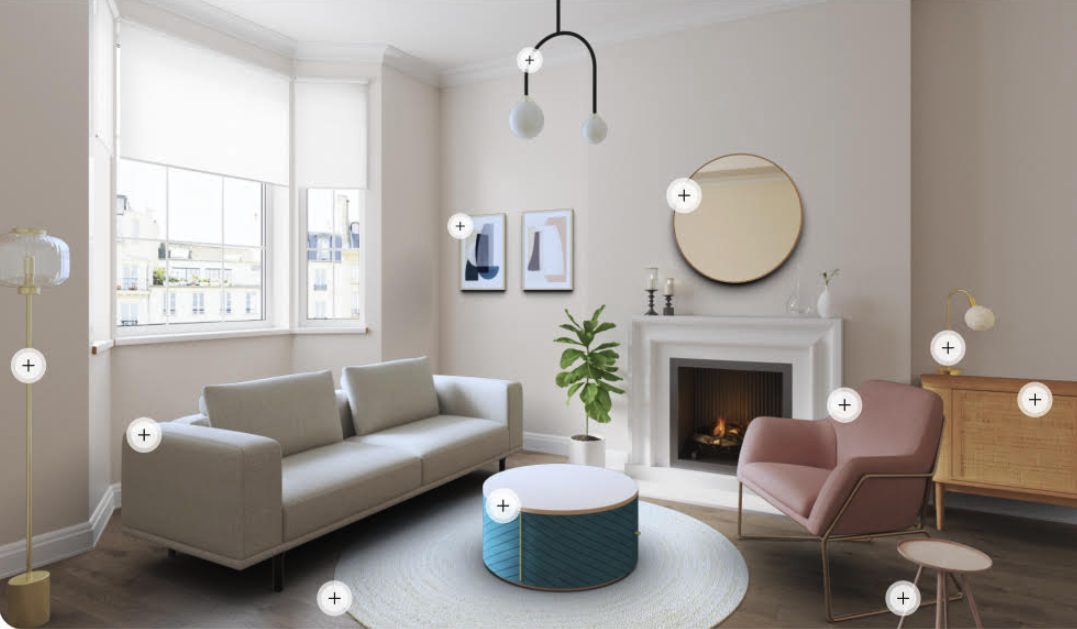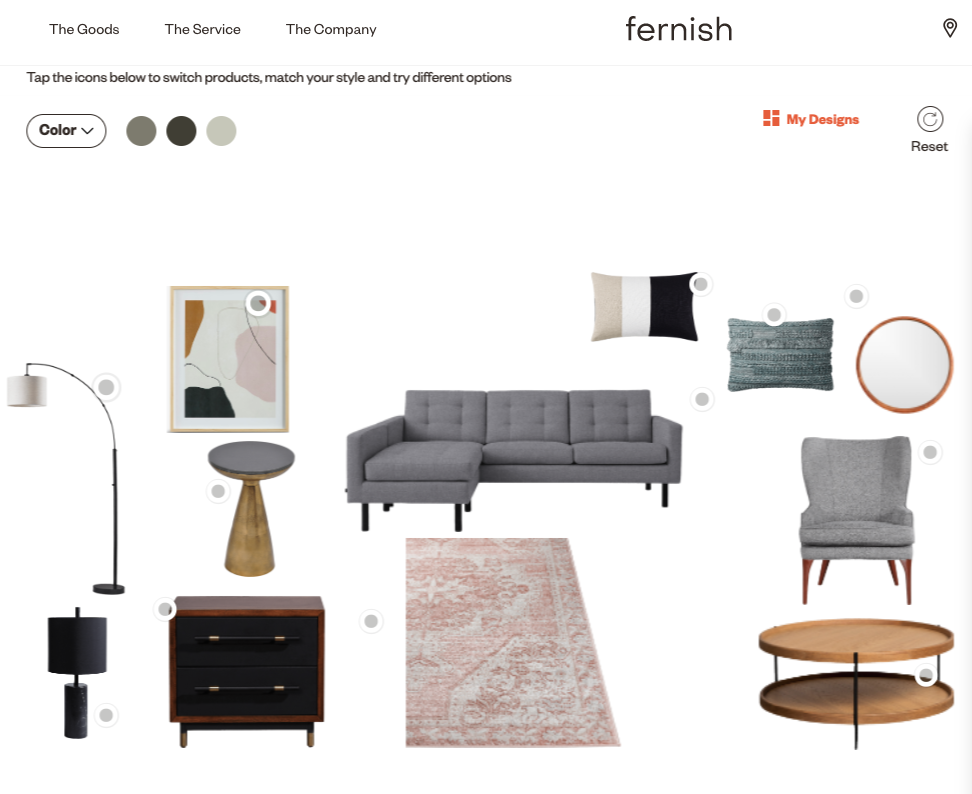AI is coming to the design industry. Actually, it’s already here. The past few years have seen a range of players, from small startups to big institutions, start to deploy artificial intelligence as part of their everyday operations. Modsy and Havenly use AI to help their e-designers work faster. Skipp uses AI to design kitchens. And now an Israeli startup, Renovai, is using an AI-powered design engine to help retailers sell home goods online.
“People search online for more than 30 hours before making a [purchasing] decision,” says co-founder Alon Gilady. “The first problem is that they have too many options. The second is the lack of confidence for customers matching items together and trying to design. It’s a major barrier, and that’s why we created Renovai.”
Gilady founded the company in 2019 with fellow entrepreneurs Alon Chelben and Avner Priel after running a rendering studio that made 3D models for architects and designers. “From that experience, we thought, There is a possibility to make technology that mimics the way interior designers think,” he says.
A B2B company, Renovai sells its technology as a plug-and-play solution for retailers to incorporate into their own sites. It offers a suite of products, ranging from a recommendation engine (Liked that minimalist coffee table? You’d love this Moroccan pouf!) to more sophisticated tools, including a module that automatically fills a rendered room with shoppable goods. Underpinning it all is a combination of computer vision and machine learning that, when combined, can perform a rudimentary version of interior design.
AI Design School
Renovai starts by taking in images of products from retailers and using an algorithm to scan, identify and tag them with characteristics. Say, for example, the item is a beige armchair. The company’s system not only perceives that the object is an armchair but also analyzes its silhouette, color, fabric pattern, leg shape and more. According to Gilady, Renovai’s system identifies dozens of characteristics for every SKU.
That, in some ways, is the easy part. The real challenge is teaching a computer to understand that this beige armchair chair looks good next to that table. Or, even more complicated, that this beige armchair looks good next to that table only if you’re going for matchy-matchy traditionalism. If you’re more into a bohemian vibe, then no, it doesn’t look good at all.

To teach its algorithm taste, Gilady’s team gathered thousands of images of interiors and fed them through it, relying on human designers to coach the system to recognize styles. (“I’m always comparing it to taking our AI to design school,” says Gilady.) Breaking down interior design into a purely computational process led to some interesting observations—for example, that “styles” are more slippery than we might think.
“At first, we thought that we’d train the system to understand whether a sofa is ‘classic’ or ‘modern’ or ‘contemporary.’ What we discovered is that the variance between ‘modern’ sofas is huge,” says Gilady. “The size, the shapes, colors can all be very different from each other, but interior designers will still consider many different kinds of sofas to be modern.” There was also confusion between styles—taken in isolation, a “Scandinavian” sofa is not that different from a “modern” sofa, and it’s difficult for an algorithm to tell the difference.
Gilady’s team tried a different approach. Rather than figuring out if a sofa was “modern,” they scanned hundreds of thousands of sofas and let the computer generate its own categories (they’re numbered, from 1 to just under 100). “These archetypes represent the entire world of sofas,” says Gilady. “When we get a new sofa from a retailer, the algorithm is able to understand if that sofa belongs to archetype 1, 2, 3 or 10. Then, once the user is trying to create a full room design, the system doesn't look for a ‘modern sofa,’ it looks for archetypes that go together.”
The third and final piece of the puzzle is to combine its identification and design functionality with customer data. Through quizzes and analysis of shopping behavior (what customers have browsed or added to their cart), Renovai puts together a profile of who it’s designing for. That results, in theory, in product recommendations that are personalized to the taste of the customer.
The software can’t pull a favor and get the best contractor in town for a project, or spend hours on the phone tracking down a missing sconce. But on a bare-bones level—finding out what people like and showing them home goods that suit their taste—Renovai is using AI to replicate a core designer skill.
Putting it in practice
That’s the theory. Then there’s the real world application. Renovai has sold its tools to a range of companies, from European brands like Made.com to Australian e-comm giant Temple & Webster to American subscription furniture platform Fernish. To test its design chops, I spent an afternoon playing around with its software on various sites.
On Fernish’s site, I took a simple design quiz and tried to answer the questions as faithfully to my own taste as possible (for reference, I asked for a living room that was “natural, vintage, cozy, artistic and minimal”), then clicked on inspirational images that appealed to me. The result was a mood board of products that included a gray midcentury sofa, some abstract art and a Moroccan rug—exactly the items I have in my real living room at this moment.

I tried the same quiz again, this time deliberately choosing options that were not me (“chic, glamorous, formal, elegant, sophisticated”) and clicking on inspirational images I didn’t like. Interestingly, though the resulting selection included a glammed-out mirror and a plush chair in a wacky print, it wasn’t as radically different—another gray sofa, another abstract print—from the first experiment as I expected. Whether that was a win or a fail for Renovai is hard to know. Had the algorithm failed to react to my fake taste, or had it seen through the ruse, looked at my history on the site and shown me what I truly wanted?
Though there were occasional idiosyncrasies (one e-commerce site kept leading me to a depressingly empty digitally rendered room), I logged off with the impression that the software basically does what Renovai claims. The algorithm is not generating Architectural Digest cover-ready rooms, but it seems to understand on a basic level that a sisal rug, a cream-colored couch, rattan accents and blue-and-white striped pillows go together—and that one Business of Home editor is predisposed toward gray sofas.
AI ROI
Renovai’s website boasts some impressive statistics—notably, that brands using its AI tools can expect 30 percent revenue increases, on average, as well as double-digit hikes to average order value and conversion rate. Michael Barlow, CEO of Fernish, says that implementing the tool has coincided with an uptick in the brand’s conversions. “It’s getting some awesome engagement—and if you engage with us, you are much more apt to convert and go through the process of placing an order than if you don’t.”
Companies pay anywhere from $20,000 to nearly $100,000 a year for Renovai, depending on the volume of designs generated through its service, says Gilady. Currently, the company working on expanding its reach in the American market and looking at adding fashion into the mix.
Should Renovai be considered a threat to real, flesh-and-blood designers? At this stage, basically no—with a caveat. Though the company’s promotional literature does have the occasional stray line about “removing the need to hire a professional designer,” what it offers feels more akin to a rudimentary e-design experience. If your business is based solely around giving clients a mood board and a few shoppable links, this technology could hypothetically present a danger. However, Renovai by design is limited to individual retailers—so unless your client only wants help buying everything from West Elm, e-designers who can jump around the web for options will have the upper hand.
There’s even less of a threat to full-service designers. However sophisticated Renovai’s algorithm is, the basic output—a shoppable mood board or rendering—does not compare to working with a designer in real life. It’s not designed to.
Gilady says that in earlier incarnations, Renovai’s team experimented with a functionality that would have allowed shoppers to upload their floor plans and design their own spaces. The challenge there, he says, was not technical but psychological. “It’s below one percent of shoppers that are shopping online [who want that level of engagement],” he says. “We had the capability to draw the living room, but we feel that most shoppers do not wish to have that. Basically, they wish to have a friendly, easy-to-use shopping experience, and that’s it.”
Homepage photo: Courtesy of Renovai





























